Humphead wrasse, also known as Napoleon wrasse, Māori wrasse, Napoleon fish, and Napoleonfish, is the King of the coral reefs.
They are known as “elephants of the coral reef,” and they are capable of reaching up to 2 meters long and have a massive body with a fascinating color morph. Although people love these fish, they are on the way to extinction. Before that, let’s learn more about these fish and try to save them. This is a comprehensive guide about the Humphead wrasse.
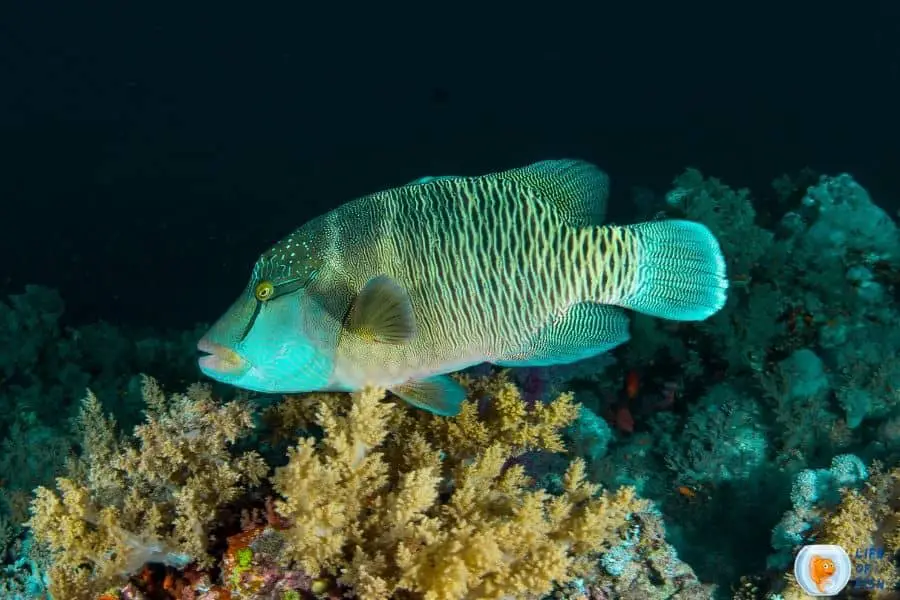
What is Humphead wrasse?
Jump To
- 1 What is Humphead wrasse?
- 2 How they looks like
- 3 Where do they live
- 4 Is Humphead wrasse going extinct?
- 5 Why is Humphead wrasse going extinct?
- 6 How many Humphead wrasses are there?
- 7 What is being done to save them?
- 8 Their behavior
- 9 What does Humphead wrasse eat?
- 10 Humphead wrasse breeding
- 11 Importance of Humphead wrasse
- 12 Can you eat Humphead wrasse?
- 13 How much is a Humphead wrasse?
- 14 Is Humphead wrasse poisonous?
- 15 Is Humphead wrasse the largest coral fish in the world?
- 16 Does Humphead wrasse live in groups?
- 17 Related Question
- 18 Conclusion
Humphead wrasse (scientific name: Cheilinus undulatus ) belongs to the family Labridae. They are the largest extant species of the Labridae family. They are found in the red sea, the Indian Ocean, and the Western Pacific ocean. You can find these fish in the tropical waters of about 50 countries, including the Tuamoto Islands, the Ryukyu Islands, New Caledonia, Maldives, Indonesia, Papua New Guinea, and Australia. They inhabit coastal reefs with soft substrate at depths of 2 meters until 60 meters deep.
The depth is its habitat, not just because it makes them visible to human eyes. They prefer deeper waters to avoid predators. Adult individuals are often found in depths of 60 to 70 meters. They like steep slopes or walls with their specific range of habitats. You can find them at a depth of 2 to 60 meters deep on reef slopes, walls, or drop-offs around coastal reefs.
Want to keep wrasse fish as pets? Our guide has everything you need to know to get started!” –
How they looks like
Apart from their size, these fish are among the most beautiful fish in the world. Like other reef fish, they have beautiful colors and striped patterns on their bodies. And this distinctive feature is what makes them so unique.
Color
They are magnificent fish with fantastic color. Their body covers with various types of dark stripes and patterns, and the color changes from dull blue-green to brilliant green or purplish-blue shades. Unlike adults, youngsters have a white body with dark scale bars and distinct black lines near their eyes.
Shape
They have large and massive body with an arched backs. As the name suggests, it has a prominent bump on its forehead. Another significant feature is their large mouth with thick lips.Their body is thick and compressed laterally. You can see their dorsal, pectoral and anal fins when they swim in the water. They have a wide and rounded caudal fin with a long base.
Size
Most female Humphead wrasses grow up to 1 meter and 100 kilograms, while males usually measure up to 2 meters and 200 kilograms.
They are the largest fish among all wrasse species. Some believe that they can grow up to 3 meters, but this is not true. Although rare, some individuals are 2.25 meters long, but this is the upper limit of the humpback wrasse. Their weight can be very different depending on their habitat.
They can easily grow up to 200 lbs (90 kg), and some individuals reach 300 lb (140 kg). The maximum recorded weight is 191kg.
Life span
The lifespan of this fish is about 30 years. The oldest reported one was 32 years old.
Male and female fish
Male are more significant than females. Only 2 to 4 percent of females are larger than males, but sex change is not common in this species.
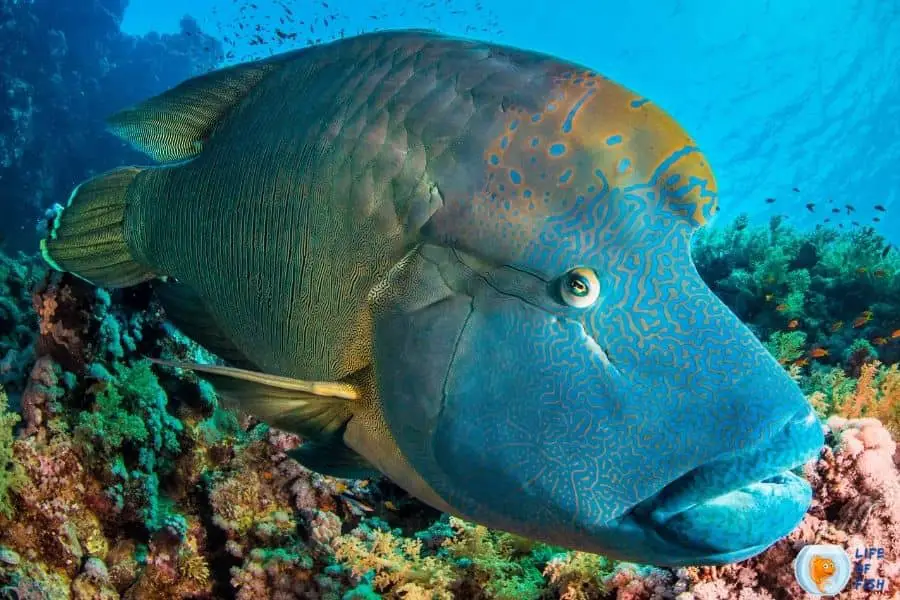
Where do they live
They live in different geographical areas with a range of water temperatures. They prefer coastal reefs and coral atolls rather than the open sea. These fish live in an extensive range of ph from 7.8 to 8.4 and a specific water depth, but they prefer a depth of 2 to 100 meters.
These fish prefer tropical waters with about 24.9 to 28.8 degrees Celsius temperatures. Juveniles lives in shallow, sandy ranges adjacent to coral reef seas. Still, adults lives in offshore and deeper areas of coral reefs, at depths of 20 meters to 100 meters.
Is Humphead wrasse going extinct?
This fish is among the largest fish in the world, but it has become scarce. Scientists are working on discovering the reason behind this situation. We cannot yet say that the Humphead wrasse is becoming extinct, but it does not look promising.
The population of these fish is decreasing rapidly. Therefore, they are an Endangered species according to IUCN Red List of Threatened Species.
Why is Humphead wrasse going extinct?
Their populations are declining rapidly due to various reasons. Some of them include,
- Overfishing – Humphead wrasses are considered a delicacy in Australia and other parts of the world. Consequently, they are overfished for food, and their size is often restricted by law.
- Heavy harvesting – Another major reason for the decrease in their population is heavy harvesting. Because they are rare fish, Humphead is often considered a prize catch. As a result, these fish are in high demand throughout the world.
- Marine pollution – Pollution in water can also significantly influence their population. Humphead wrasses are very sensitive to water pollution, so they do not thrive in polluted waters.
- Climate change – scientists believe that climate change is also causing a decrease in their population.
- Catching juveniles for aquarium trade – Humphead juveniles kept as pets. This isn’t reassuring for the population of Humphead wrasses because it disturbs their natural population.
- Habitat loss and destruction – As they tend to live in a particular water depth, it will also reflect on their population if their habitat is destroyed.
How many Humphead wrasses are there?
There are no precise statistics on the population. Some scientists estimate that there is less than 1,0000 adult Humphead in the world. This may not be very alarming for you, but unfortunately, there are no juveniles in this number.
What is being done to save them?
Several countries are trying to save this species by taking specific measures.
Australia – The government of Australia, has announced to protect them. They ban their fishing and consumption in Queensland and Western Australia, where they are most common.
Borneo Island – The government took some initiatives to protect them. Humphead Wrasse Conservation Areas announced by the local government of Sabah, Malaysian Borneo Island. This decision is to protect the fish from fishing before they can breed.
The state of Hawaii – The government has also taken specific initiatives to protect the them.
The Maldives – The government has instituted an export ban in 1995 to protect these species.
China – In Guangdong Province, certain permits are required to sell these fish.
Indonesia – Indonesia permits fishing for research, mariculture, and licensed artisanal fishing only.
Taiwan – Declared as a protected species in 2014. If found, he will face fines ranging from NT$300,000 to $1.5 million and prison penalties ranging from 6 months to 5 years under the Wildlife Conservation Act for hunting or killing the species.
Papua New Guinea – Some measures are being taken to protect them.
Philippines – They are listed as a protected species in the Philippines under the Wildlife Act of 1997.
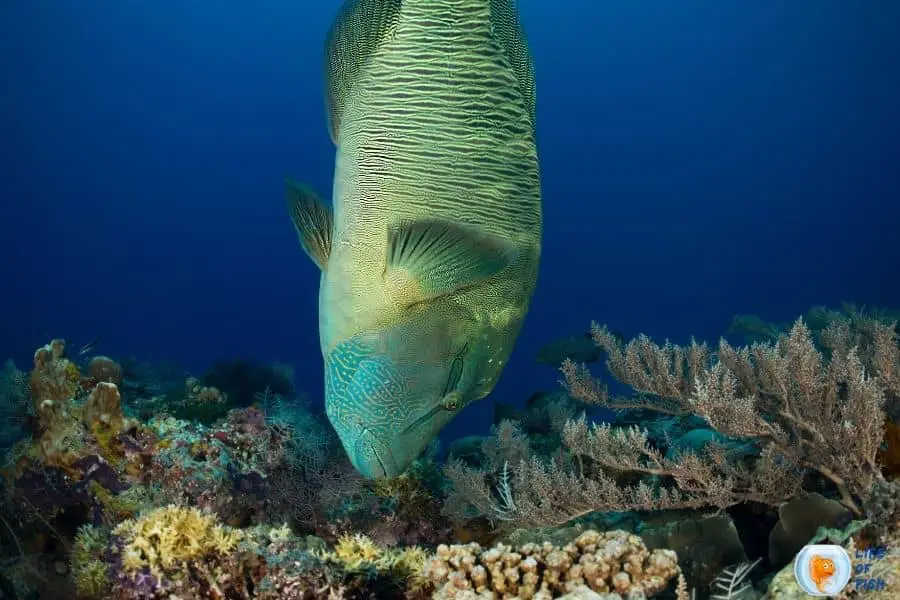
Their behavior
Regardless of their size, these fish lives among coral reefs sheltering much other smaller species. Because of this, they are considered an umbrella species.
Like other wrasse species, male fish are very territorial and aggressive toward both adults and their own kind. They are difficult to house in aquariums because they beat each other up during mating. They have interesting feeding behavior. Humphead wrasse are primarily diurnal opportunistic predators that hunt sea urchins, crabs, lobsters, snails, and other types of fish.
Sea urchins and pelecypods mostly hide under the sand. To get these invertebrates out of the sand, these fish dig the sand by expelling water with their noses.
During this process, they also search for food with their beaks. They also rely on fish excavators like stingrays to find food. To crack the hard shells of sea urchins, Humphead wrasses often carry them with their mouths to rock and strike the prey against the rock with hard, sideways head movements.
They’re also known to join forces with the roving coral grouper for hunting. Juveniles prefer a more secluded existence in regions dominated by dense branching corals, bushy macroalgae, or seagrasses.
What does Humphead wrasse eat?
Humphead wrasses are opportunistic predators that feed on a wide variety of prey, primarily pelecypods, and sea urchins. They also eat crabs, lobsters, snails, and other types of fish. However, most of their diet consists of invertebrates such as mollusks such as gastropods, pelecypods, echinoids, crustaceans, and annelids.
Humphead wrasse breeding
They reach sexual maturity at about 5 to 7 years of age. They have a very slow breeding rate because of their slow growth rate, long life expectancy, and late sexual maturity.
These fish gather as large mating groups and spawn as pairs. A group may consist of about 100 individuals, occurring at the end of the reef on the down-currents. The courtship behavior of these fish involves the parading of the females by males in a line. The male fish pairs off with one female and then swims away with it to find a suitable site.
The pair then release their eggs to the open waters (hence called pelagic spawners). The eggs are spherical, and each egg is approximately 0.65 mm in diameter. The pelagic eggs and larvae finally colonize or close to coral reef regions.
Protogynous hermaphriditism
Although some juveniles develop into males directly, the females can also transform into males when necessary. According to Cathleen Bester of the Florida Museum of Natural History, this sex transition occurs typically at the age of nine years, despite Wrasses being born with both gender organs.
It is still unknown why this transition happens and how it is triggered. Although the sex change in these wrasses does not seem to be like clownfish, there are some apparent similarities.
It appears when we put two females in a tank together, one becomes more dominant than the other, and thus, the subordinate fish is more likely to become a female and the dominant one a male. The sexual transition in these wrasses may also be caused by the hormonal cycles of these fish.
There are some differences between the sexes, such as size and shape. This can be so pronounced that it is sometimes easy to distinguish a female from a male.
Importance of Humphead wrasse
- Ecosystem balance
Large fishes such as the Humphead wrasse play a key role in maintaining the ecosystem balance because of their position in food chains. The removal or decrease of such fish may cause overpopulation of other species and out-weigh the population control.
They also plays a role in their ecosystem because the fish feed on reef urchins. The fish is a known predator on a sea urchin called Diadema. Further, these fish act as umbrella species. Scientists often name these fish as an umbrella species because protecting their habitat will also mean the protection of other associated species.
- Humphead wrasse as a food source
They are expensive fish, especially in their native regions. The quality of this fish is essential not only because of its flavor but also for its health benefits. These fishes are harvested locally in Malaysia, Indonesia, and Sabah Malaysia. The fish is also imported into local European communities, although the governments ban it.
- Sportfishing
Because of their rarity and size, they are popular in sportfishing. Anglers may take these fish by using large surface lures and large bait.
- Aquarium Trade
They were popular in the aquarium trade because of its rarity. However, many illegal traders have caught and harvested this fish without following international law. This catching is partly due to the lack of awareness of the conservation status of this species. The number of Humphead in the wild has decreased considerably because of this.
The increase in demand for Humphead wrasses has reduced its population even more and put this species under the threatened and endangered list.
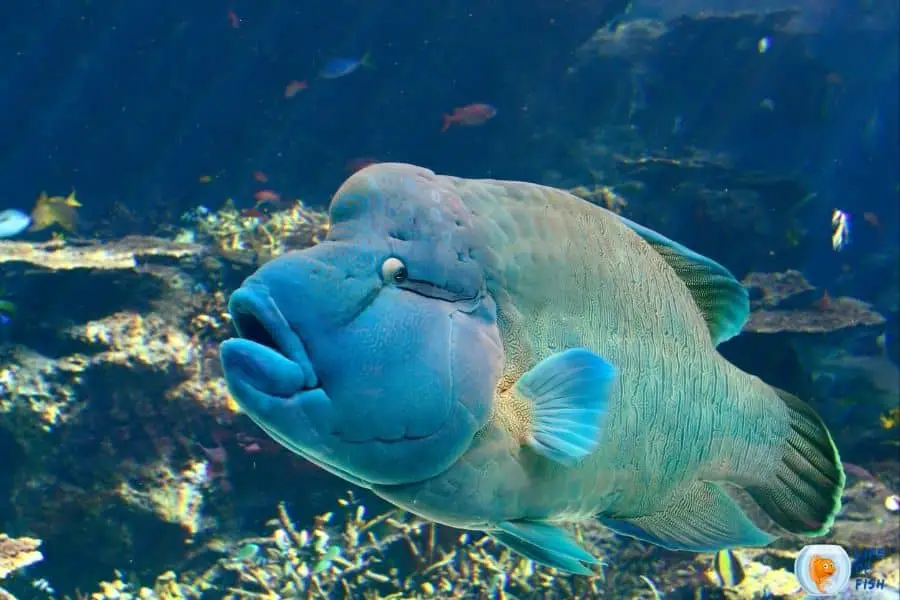
Can you eat Humphead wrasse?
Yes. They are considered a delicacy and are sold for high prices because of their quality. It is also nutritious because of its high protein, low-fat content, and selenium levels. The fish may be smoked, steamed, grilled, or fried. These fish were once available only for royalty, but now they are available as a luxury food for the rich and wealthy.
The high demand for this fish has put it on the threatened and endangered list.
That is why the Humphead wrasse has been placed in Appendix II of CITES (Convention on International Trade in Endangered Species of Wild Fauna and Flora). Although they are an endangered species, this fish is still being traded despite the ban.
How much is a Humphead wrasse?
A pound may cost between $120 and $250. This is a very expensive fish because of its quality and rarity. However, its price has dropped due to the growing population in some places. Fish market prices may vary depending on the location and availability of this fish.
Is Humphead wrasse poisonous?
Although they are edible and are sometimes consumed by humans, there is a slight danger in eating these fish. This danger comes from the presence of ciguatera toxin found in this fish. Ciguatera toxins cause ciguatera poisoning and may cause the following:
- nausea and vomiting
- cold allodynia
- intense burning sensation in the mouth and throat
Ciguatera toxins are found in algae that the prey species feed on. They may also cause ciguatera poisoning if the fish is consumed raw, especially those caught where reef sharks are found. However, it has been shown that the meat of Humphead wrasse is not poisonous when appropriately cooked. It is also not poisonous if dried, salted, or smoked.
Is Humphead wrasse the largest coral fish in the world?
No. the Largest coral fish in the world is the whale shark. It is also the largest fish globally and may reach a size of about 18.8 m. However, they are the largest wrasse species in the Labridae family.
Does Humphead wrasse live in groups?
No. they do not prefer to live in groups. They often stay in solitary and sometimes live in pairs. However, they gather when it is time to mate. These fish are also known to be aggressive towards each other when in close proximity.
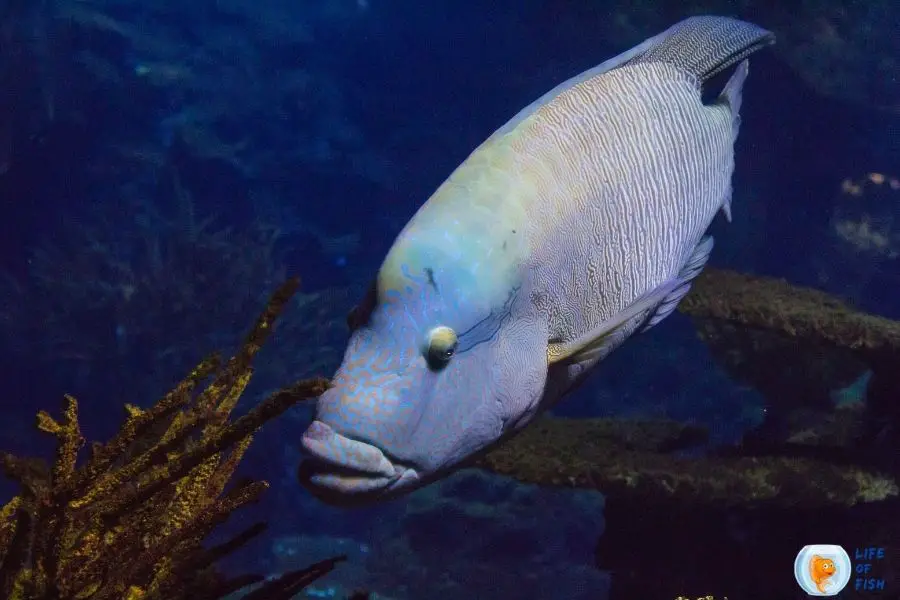
Related Question
What kind of fish is a Humphead wrasse?
They are a wrasse species that lives in the Indo-Pacific oceans. Scientists often name these fish as an umbrella species because protecting their habitat will also mean the protection of the other species within the area. They are also popular for its huge size, rarity, and colorful fin extensions.
Are Humphead wrasse endangered?
Yes. they are an endangered species. In some regions, this fish is extinct because of overfishing and habitat loss. A few populations of Humphead in the Raja Ampat and Maluku areas are still abundant.
Are Humphead wrasse carnivores?
Yes. They are carnivorous fish that mainly feed on sea urchins and other invertebrates.
Do sharks eat Humphead wrasse?
Yes. Reef sharks and other predators may eat them as their prey.
What is the size of a Humphead wrasse?
A fully grown fish may measure about 90 cm in length and weigh up to 160 kg.
Do Humphead wrasses migrate long distances?
No. Although Humphead wrasses migrate to spawn, they don’t migrate long distances. However, local migrations happen regularly.
Conclusion
Humphead wrasse is the largest wrasse species in the Labridae family. It is also endangered because of overfishing and habitat loss. Humphead wrasses are popular as a luxury food in some countries and are also important in the aquarium trade.
The meat of them is not poisonous if it is properly cooked or dried, salted, or smoked. However, they may cause ciguatera poisoning when consumed raw in some regions. However, we must avoid hunting these fish because they are endangered and can quickly become extinct if not given enough protection.
Read Next : Asian Sheepshead Wrasse | Incredible Facts About Them | Sixbar Wrasse (Thalassoma Hardwicke) | Incredible Marine Fish |
